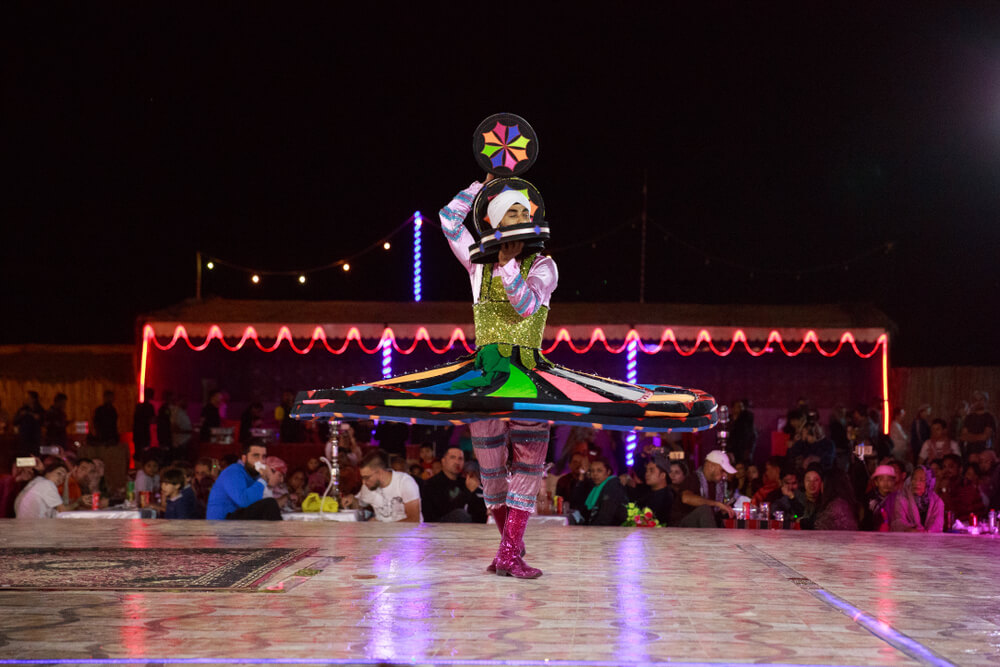As the Camp Manager at ESA Tours, I’ve had the privilege of welcoming thousands of guests to Dubai’s golden desert, each arriving with curiosity and leaving with unforgettable memories. From sunrise balloon flights to thrilling dune adventures, every safari we organize is crafted to reveal the magic of the Arabian desert in its purest form.
In this guide, I’ll walk you through the different types of desert safaris in Dubai, sharing insider tips and expert insights to help you choose the one that fits your travel style ,whether you’re a thrill-seeker, a family traveler, or someone looking for a romantic escape under the stars.
What Is a Desert Safari Dubai?
A desert safari Dubai is a guided tour across Dubai’s vast dunes in a 4×4 vehicle, combining adventure, culture, and nature in one unforgettable experience. It’s your chance to witness the raw beauty of the desert while enjoying activities like:
-
Dune bashing in a 4×4 vehicle
-
Camel riding and sandboarding
-
Falconry displays and desert photography
-
Live entertainment shows (Tanoura, Fire & Belly Dance)
-
Traditional BBQ dinner at a Bedouin-style camp
Every desert safari is unique — depending on timing, inclusions, and the level of comfort you’re after.
Main Types of Desert Safari Dubai
At ESA Tours, we offer a variety of desert safari experiences to match your preferences. Let’s explore each one in detail.
1. Morning Desert Safari in Dubai
Perfect for thrill-seekers and early risers, the Morning Desert Safari delivers high-octane adventure against the backdrop of sunrise over Dubai’s golden dunes.
What to Expect
Your journey starts early morning, around 7:00 AM, with pickup from your hotel in a 4×4 Land Cruiser. As you drive towards the Lahbab Desert, you’ll witness the sky turning from soft orange to bright gold — a sight worth waking up early for.
After reaching the desert, buckle up for 30–45 minutes of dune bashing, where skilled drivers navigate the high red dunes, offering a roller-coaster-like experience. You can then try sandboarding, camel riding, or stop for desert photography.
Highlights
-
Early morning pickup and drop-off
-
30–45 minutes of dune bashing
-
Sandboarding and camel riding
-
Soft drinks and refreshments
-
Optional quad biking or buggy ride Dubai
Best For
Adventurers, photographers, and tourists with limited time in Dubai.
2. Evening Desert Safari Dubai
The Evening Desert Safari is the most popular option — combining adventure, culture, food, and entertainment. As the sun sets over the dunes, the desert transforms into a magical landscape.
What to Expect
Your experience begins in the afternoon with a scenic drive to the desert. After an exciting dune bashing session, you’ll arrive at a traditional Bedouin-style camp, where a world of Arabian hospitality awaits.
Enjoy camel rides, henna painting, Arabic coffee, and dates, followed by live performances like the Tanoura show, belly dancing, and fire acts. As night falls, indulge in a sumptuous BBQ buffet dinner under the stars.
Highlights
-
Dune bashing & sandboarding
-
Camel riding and falcon photos
-
BBQ buffet with vegetarian & non-vegetarian options
-
Live entertainment shows
-
Arabic coffee, dates & shisha (optional)
Best For
Couples, families, and first-time visitors who want a complete desert experience.
3. Overnight Desert Safari
If you dream of sleeping under a blanket of stars, the Overnight Desert Safari offers the ultimate Arabian night experience.
What to Expect
This package includes everything from the evening safari — plus a magical overnight stay at the desert camp. After dinner and entertainment, relax by the bonfire, enjoy stargazing, and then rest in cozy Bedouin-style tents equipped with sleeping bags and blankets.
Wake up to a stunning sunrise and a delicious breakfast before returning to your hotel.
Highlights
-
Full evening desert safari experience
-
Overnight stay in the desert camp
-
Stargazing & bonfire experience
-
Traditional breakfast in the morning
-
Private or shared tents available
Best For
Couples and families seeking an immersive, serene desert escape.
4. Private Safari Dubai
For travelers who value exclusivity and comfort, the Private Desert Safari is a premium option that ensures a personalized and private experience.
What to Expect
Enjoy private 4×4 transfers, your own driver, and customized activities. Whether it’s a romantic date, a family outing, or a VIP guest experience, everything is tailored to your preference.
You can choose between morning, evening, or overnight options, with add-ons like private dining setups, luxury tents, or dedicated falcon shows.
Highlights
-
Private 4×4 vehicle and driver
-
Customizable itinerary
-
Optional fine-dining dinner setup
-
Flexible timing and activities
-
Ideal for groups, couples, or VIP guests
Best For
Luxury travelers, honeymooners, and corporate groups.
5. Premium Desert Safari Dubai
The Premium Desert Safari by ESA Tours combines adventure, luxury, and cultural immersion — offering the best of Dubai’s desert in one package.
What to Expect
Start with a thrilling dune bashing ride followed by premium activities like falcon photography, camel safari, and gourmet BBQ dining. Enjoy priority seating at the camp, table service, and exclusive amenities like private shisha lounges and VIP seating for live shows.
Highlights
-
Priority 4×4 pickup & drop-off
-
Premium BBQ buffet dinner
-
VIP seating & service
-
Live performances
-
Arabic coffee, dates, and soft drinks
Best For
Luxury travelers who want a five-star desert experience.
6. Adventure Desert Safari with Quad Biking & Dune Buggy
For those craving adrenaline, ESA Tours offers Adventure Desert Safaris that include powerful off-road rides across the dunes.
What to Expect
After dune bashing, hop onto a quad bike or dune buggy and navigate the sand dunes yourself under professional supervision. The tour ends with refreshments or optional camp activities.
Highlights
-
Dune bashing & self-drive quad biking Dubai
-
Camel ride & photo stops
-
Safety gear and guidance included
-
Soft drinks & water provided
Best For
Thrill-seekers and groups looking for high-energy adventure.
7. Sunrise Desert Safari in Dubai
If you love peace and photography, the Sunrise Desert Safari is a beautiful way to start your day.
What to Expect
Begin before dawn, travel to the desert, and witness the sunrise painting the dunes in shades of orange and gold. Light breakfast, camel rides, and photo opportunities are included.
Highlights
-
Early morning pickup
-
Dune bashing & sunrise views
-
Light breakfast & refreshments
-
Camel ride & falcon show
Best For
Nature lovers, photographers, and couples seeking a romantic start.
Comparison Table: Morning vs Evening vs Overnight Desert Safari
| Feature | Morning Safari | Evening Safari | Overnight Safari |
|---|---|---|---|
| Timing | 7:00 AM – 11:00 AM | 3:00 PM – 9:00 PM | 3:00 PM – 9:00 AM |
| Dune Bashing | ✔️ | ✔️ | ✔️ |
| Camel Ride | ✔️ | ✔️ | ✔️ |
| BBQ Dinner | ❌ | ✔️ | ✔️ |
| Entertainment Shows | ❌ | ✔️ | ✔️ |
| Breakfast | ❌ | ❌ | ✔️ |
| Overnight Stay | ❌ | ❌ | ✔️ |
| Best For | Short trips & adventure lovers | Families & first-time visitors | Couples & stargazers |
Tips Before Booking Your Desert Safari
-
Dress comfortably — light clothes and closed shoes are ideal.
-
Carry sunglasses, hats, and sunscreen to protect against the sun.
-
Avoid heavy meals before dune bashing.
-
Pregnant women or guests with heart/back issues should skip dune bashing.
-
Always book with licensed operators like ESA Tours for safety and insurance coverage.
Why Choose ESA Tours for Dubai Desert Safari?
ESA Tours is one of Dubai’s most trusted adventure tour providers, known for creating memorable, safe, and premium-quality experiences.
When you book a desert safari with us, you get:
-
Licensed, experienced desert drivers
-
DTCM-approved vehicles
-
Customizable safari options (standard, deluxe, premium)
-
Affordable packages with no hidden costs
-
Free pickup and drop-off from your Dubai hotel
Whether you’re traveling solo, with family, or in a group, ESA Tours ensures a seamless, fun, and safe desert safari experience.
Book Your Desert Safari Dubai with ESA Tours
Ready to experience Dubai’s desert like never before? From thrilling dune rides to starlit dinners, ESA Tours promises memories that last a lifetime. Book now at +971 55 873 2018 or email us to enjoy exclusive discounts on morning, evening, and overnight desert safaris in Dubai.
FAQs – Desert Safari
What is the best time for a desert safari in Dubai?
The best time for a desert safari in Dubai is between October and March, when the weather is cool and pleasant. The mild temperature makes it ideal for outdoor activities like dune bashing, camel rides, and evening shows.
How much does a desert safari cost in Dubai?
The price of a desert safari in Dubai starts from AED 150 per person for a shared package and can go up to AED 1,200 or more for luxury or private experiences with premium inclusions.
What should I wear on a desert safari in Dubai?
Wear light, breathable clothing such as cotton shirts and trousers during the day. In winter, carry a light jacket or shawl. Always wear closed-toe shoes for comfort during sand activities.
Is desert safari safe for children?
Yes, ESA Tours’ desert safaris are family-friendly. However, children below 5 years are not allowed to join dune bashing or high-speed activities for safety reasons.
Can I book a private safari in Dubai?
Absolutely! ESA Tours offers private desert safaris with luxury 4×4 transfers, personalized service, and exclusive camp setups — perfect for families, couples, or small groups seeking privacy and comfort.
What activities are included in a desert safari?
Typical activities include dune bashing, camel riding, sandboarding, falconry, BBQ dinner, live cultural shows, and henna painting. Premium packages may include VIP seating and photography.
How long does the desert safari last?
A standard desert safari in Dubai lasts around 5 to 6 hours, including pick-up, adventure activities, and dinner. Overnight safaris extend into the next morning with breakfast and stargazing.
Can I combine a desert safari with other activities?
Yes! ESA Tours offers combo packages combining desert safaris with hot air balloon rides, dune buggies, or quad biking — perfect for adventure lovers who want a full desert experience.
What to wear for Dubai desert safari (Outfit Ideas)?
For women: flowy tops, light trousers, or long skirts.
For men: breathable shirts and shorts or track pants.
Avoid black clothing, as it absorbs heat. Closed shoes and a scarf are recommended.
Where is the desert safari in Dubai?
Most desert safaris in Dubai take place in Lahbab (Red Dunes) or Al Awir Desert, located about 45–60 minutes from Downtown Dubai. ESA Tours operates in both regions with DTCM-licensed guides.
What is desert safari in Dubai?
A desert safari in Dubai is a guided adventure into the Arabian Desert that includes dune bashing, camel rides, sunset photography, and cultural entertainment. It’s one of the top-rated experiences in the UAE.
How to book a desert safari in Dubai?
Booking is simple! Visit ESA Tours’ official website. Choose your preferred morning, evening, or overnight safari package and confirm your slot instantly.
What is the price of desert safari in Dubai?
The average desert safari Dubai cost ranges from AED 150 to AED 400 for shared tours, while private luxury safaris cost between AED 800–1,200 per vehicle, depending on inclusions.
Which is the best desert safari in Dubai?
The Evening Desert Safari by ESA Tours is the most popular featuring sunset views, dune bashing, BBQ dinner, and live entertainment. For a premium experience, try our Luxury Private Safari.
How much for desert safari in Dubai?
Expect to pay AED 150–250 for a standard package and AED 700+ for private luxury options. Prices vary by time (morning, evening, overnight) and inclusions such as dinner or buggy rides.




